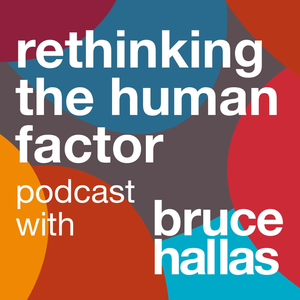
Re-thinking The Human Factor with Bruce Hallas
Marmalade Box

1 Listener
All episodes
Best episodes
Seasons
Top 10 Re-thinking The Human Factor with Bruce Hallas Episodes
Goodpods has curated a list of the 10 best Re-thinking The Human Factor with Bruce Hallas episodes, ranked by the number of listens and likes each episode have garnered from our listeners. If you are listening to Re-thinking The Human Factor with Bruce Hallas for the first time, there's no better place to start than with one of these standout episodes. If you are a fan of the show, vote for your favorite Re-thinking The Human Factor with Bruce Hallas episode by adding your comments to the episode page.

The human factor. A view from Brazil.
Re-thinking The Human Factor with Bruce Hallas
11/03/21 • 48 min
In this episode we look through the eyes and experiences of an education and awareness manager from Brazil. We explore the consistent challenges, no matter where you are or what your culture is, when it comes to employee awareness, behaviour and culture.

1 Listener
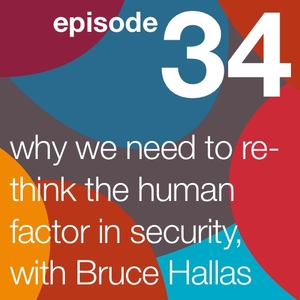
Why we need to re-think the human factor in security, with Bruce Hallas
Re-thinking The Human Factor with Bruce Hallas
04/07/20 • 69 min
Why we need to re-think the human factor in security, with Bruce Hallas
Bruce Hallas sits in the hot seat for a change as Alexia of Marmalade Box grills him, for this: Series 3, Episode 4 of the Re-Thinking the Human Factor Podcast. Having received a lot of emails asking us for more information about Bruce Hallas, the host of this podcast, Alexia agreed to put Bruce through some viewer lead questioning in the hopes of delving deeper into his background and expertise.
Having trained in accounting and law, Bruce started his work life in business development, outside the realms of tech, and found himself passionate about security awareness and human behaviour. Via a series of questioning, 7 years ago Bruce was lead to his groundbreaking research that lead to his book ‘Rethinking The Human Factor’. Apart from his work as a researcher and author, he also runs Marmalade Box, a company dedicated to helping organisations cultivate and design a positive security awareness by raising awareness and influencing behaviours.
Bruce is an expert in reducing risk and helping companies design security processes that reduce the guesswork from the human factor. We know you will enjoy listening to how and why Bruce is so passionate about his chosen occupation and how you can benefit from his vast understanding.
AS YOU LISTEN TO THE EPISODE, IF YOU FIND YOURSELF WANTING TO IMPLEMENT SOME OF THE INSIGHTS YOU’RE GAINING BUT YOU FEEL YOU NEED A LITTLE HELP, PLEASE DO GET IN TOUCH WITH ME AT:
JOIN BRUCE HALLAS AND ALEXIA AS THEY DISCUSS:
- The questions Bruce asked himself when he started his research journey.
- How understanding the human factor allows for better engagement.
- Breaking down the entire system within information security to better the process.
- The Analogies Project and how analogies help in shaping culture and behaviour.
- Who benefits the most from the Rethinking The Human Factor research?
- Designing with the human in mind.
- Does evidence point to the validity of the frame work created from the research done in Rethinking The Human Factor?
- The importance of establishing a cohesive vision as an anchor.
- How personal values influence culture.
- What can my organisation do to benefit from this?
RESOURCES AND TOPICS FOR FURTHER STUDY
- Rethinking The Human Factor by Bruce Hallas
- Nudge by Richard H. Thaler
- The Power Of Analogy by Dieter Wanner
MORE ABOUT BRUCE HALLAS:
Please subscribe to the podcast in iTunes, and if you enjoyed this interview, please share with your friends and colleagues and leave a 5 star rating and review.
Thanks for listening and sharing.
Bruce & The Re-thinking the Human Factor Podcast Team

How semiotics can help us engage more effectively
Re-thinking The Human Factor with Bruce Hallas
03/29/18 • 53 min
EPISODE 10 SUMMARY - RACHEL LAWES
————————————————
Joining Bruce Hallas on Episode 10 of the Re-thinking the Human Factor Podcast is Dr. Rachel Lawes, who comes to the show with a background in the field of semiotics. Don’t worry, if you’re not familiar with the term, you’re probably in good company.
However, upon learning more about Rachel and the field of semiotics prior to recording the interview, we knew she had something of interest, substance, and worth to bring to the conversation around Cyber Security Awareness, Behaviour, and Culture.
MORE ABOUT RACHEL
If you go to market research conferences, you’ve probably met her already. She’s one of the original founders of British commercial semiotics and she never stops being excited about what it can do. She uses semiotics and related methods, backed up by a comprehensive knowledge of social science, to rejuvenate brands, innovate products and services and steer comms. She delivers research, insights and strategic guidance to brand owners. She delivers training in advanced research methods for both client side and agency side users. She also supplies consultancy services to ad agencies, design agencies and large branding agencies.
From time to time she works with universities because she loves to teach. [1]
JOIN RACHEL LAWES AND BRUCE HALLAS AS THEY DISCUSS:
- What semiotics is.
- In reference to a challenge often put our way regarding the applicability of insights from without the security industry — whether the insights gained through semiotics be applied to both sides of the fence, so to speak, both externally AND internally, as in the case of within an organization.
- One fascinating consequence of digital culture — that written language has taken on a life of its own in a way that really haven’t seen in our life times.
- It’s no longer really required that you follow the rules you learned in school. What’s more important is getting your message across, which might involve substantial use of abbreviations, emoji’s, etc. People communicate using language and text now more than they have done for a long long time.
- The work of semiotics is partly about observing what’s going on in a given audience to try to understand what it is they’re giving off, what the signs are you see in the audience which may be a reflection on how they would respond to you presenting something to them.
- How semiotics can help one engage more effectively and influence changes more effectively.
- Studying signs and symbols (semiotics) gives one an understanding of what is driving people’s behaviour from a cultural perspective. This is important because, as discussed with Gert Jan Hofstede in Episode 06 of the Re-thinking the Human Factor Podcast, culture forms everybody - there’s no escape from it.
FURTHER STUDY AND RESEARCH
MORE ABOUT RACHEL LAWES:
- Website [1]
Please subscribe to the podcast in iTunes, and if you enjoyed this interview, please share with your friends and colleagues and leave a 5 star rating and review.
Thanks for listening and sharing.
Bruce & The Re-thinking the Human Factor Podcast Team

What Security Awareness Professionals Can Learn From Marketers and Understanding the Customer Journey, with Kenda MacDonald
Re-thinking The Human Factor with Bruce Hallas
02/18/20 • 70 min
Kenda MacDonald joins us in the hot seat for Series 3, Episode 2 of the Re-Thinking the Human Factor Podcast. We are absolutely thrilled to have Kenda MacDonald on the show today. As I’m sure you’ll agree, she has the knack for pulling things together in a way that is easy for you, the listener, to understand and digest. We could have talked all day but we managed to stop ourselves..... just.
Formerly a forensic psychology major, Kenda MacDonald is now an award winning business owner, and the award winning author of ‘Hack The Buyer Brain’. Kenda is the founder and CEO of Automation Ninjas, and she sees her mission as helping forward thinking businesses get better quality leads that convert better, for happier customers that come back and spend more. The key to this is combining buyer psychology and marketing automation.
In our show today, we're going to dive into what we in the security awareness profession can glean from insights provided by marketers such as Kenda and their understanding of human behaviour and decision-making.
"It is incredibly important to know your target market and make sure they keep on coming back for more, and with so much data available to businesses these days, there really has never been a better time to do so."
JOIN KENDA MACDONALD AND BRUCE HALLAS AS THEY DISCUSS:
- The importance of making the time to tailor your customer journeys via understanding why and how your customers stay the long haul with you as a business provider — whilst remaining ethically tethered. And how this can be applied to marketing and implementing your security awareness.
- How does knowing human behaviour and conscious consumerism aid your business?
-
- Prevent choice paralysis. Being able to cater directly to an individual and know whether to offer them ‘A’ or ‘B’ saves time and money for both you and your users.
- How giving people conscious choices they will want to make, for the benefit of all, can help get things done.
- A happy, fulfilled customer is bringing you, the service provider, customer lifetime value via loyalty and advocacy. Building your ambassador network by learning from how it is done in marketing loyalty schemes.
- Customer Lifetime Value: The benefits of a lifetime customer versus a one off purchaser, and what we can learn from this.
- Time viewed as a lifetime value. Gaining value via full attention and usage of apps.
- It’s far more cost effective to spend time getting to truly know your audience, rather then thrashing about in the dark.
- Give people a positive experience with little friction and they will help to generate corporation and seed new awareness within the culture around them.
- The importance of data gathering when trying to shape human behaviour.
- Humans have developed to be social animals. They have group identities and labels whether they like to admit it or not. Like attracts like and stereotypes do exist.
- The Customer’s Journey can be applied when implementing security awareness-
-
- The customer’s journey is everything a consumer has to do along a path to buy and utilise a product.
- Avoid making the mistake of forgetting about the fact that purchasing something is only one part of a long journey as a consumer.
- By utilising customers’ ‘moments of truth’ you gain more lifetime value from them.
- Understanding mental biases -
-
- The brain creates a great deal of rule sets to help it make sense of the reality around it.
- A cognitive bias is a systematic error in thinking that affects the decisions and judgments that people make. Some of these biases are related to memory.
- The individual can develop a bias towards a product or service due to recent repetition of exposure to it. The brain likes availability and ease of use.
- Marketing security more effectively and driving behaviour using the Heroes Journey -
-
- Craft content to make your user feel like a hero in their own story,
- Validate with data to see if your users are looking for the content you are providing.
- How gathering data helps you understand the wants and desires of your customers to aid you in bringing them their happily ever after.
RESOURCES AND TOPICS FOR FURTHER STUDY
- Hack The Buyer Brain
- A Prescription For Cutting Costs
- The Availability Bias
- The Sunk Cost Fallacy
MORE ABOUT KENDA MACDONALD:
Plea...
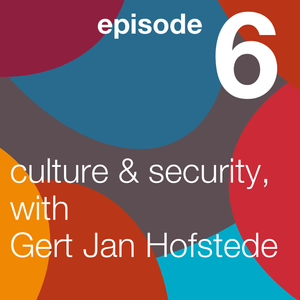
Culture and Security, with Gert Jan Hofstede
Re-thinking The Human Factor with Bruce Hallas
11/29/17 • 75 min
The relationship between culture and security is an important one and one that is discussed a lot. Unfortunately, many people miss the point somewhat when exploring culture and security. The obvious place to start is the security culture within an organisation, but let’s not dismiss organisational culture too quickly. Better still, let’s also take a look at industry culture and national culture. So you see, when we start looking at culture and security, there’s more to it than we might initially assume. So we thought this would make an excellent podcast episode.
Today, Bruce is joined by Gert Jan Hofstede. Gert Jan is a population biologist and social scientist hailing from the Netherlands whose research and publications have provided many with deeper understanding in the areas of cultural evolution, societal change, cultural stability, and how those forces interact with and have influence upon one another. He is also known for his work in social simulation as well as for a number of books he has co-written with his father, Geert Hofstede. In this episode, Bruce and Gert Jan discuss a wide variety of organization and culture-related topics that have important implications for the Cyber Security industry.
“It is as if you were a fish and they asked you to describe the air... If you’ve always lived in one place in the world, then it’s very hard for you to see that behaviors from another place that seem strange, illegal, ridiculous... that those behaviors can make sense, but within a larger [cultural] system.”
Join Bruce and Gert Jan in this episode of Re-thinking the Human Factor as they explore:
- How awareness of cultural differences (or lack thereof) can be an opportunity for greater collaboration between groups, or greater friction, and how this awareness contributes to one’s ability to understand and effectively communicate cross-culturally
- The need for organizations to achieve a sense of mutual cultural understanding as the starting place for implementing organizational change rather than striving to achieve cultural homogenization as the means for implementing that change
- Different perceptions of what cultural differences mean to an organization (barrier to progress, a catalyst for a breakthrough, etc.), and the importance of realizing that these differences do exist so that one can begin to try and understand them as a means of navigating the challenges and growth potential afforded by these differences
- The importance that “cultural ambassadors” within an organization be, first and foremost, acceptable to the cultural audience whom they seek to address
- 4 helpful cultural metaphors to help with navigating cross-cultural organizational communication:
- The Family (Asia and Africa)
- The Machine (Germanic/Northern Italy type of region)
- The Market (Anglo-Saxon, the UK and North America)
- The Pyramid (the Mediterranean and Slavic countries)
MORE ABOUT GERT JAN HOFSTEDE, HIS BOOKS, AND HIS RESEARCH:
Associate Professor at the Information Technology Group at Wageningen University & Research // Population biologist and social scientist in information management and social simulation // Interested in the interplay of the contrasting forces of cultural evolution, societal change and cultural stability.
Please subscribe to the podcast in iTunes, and if you enjoyed this interview, please share with your friends and colleagues and leave a 5 star rating and review.
Thanks for listening and sharing.
Bruce & The Re-thinking the Human Factor Podcast Team
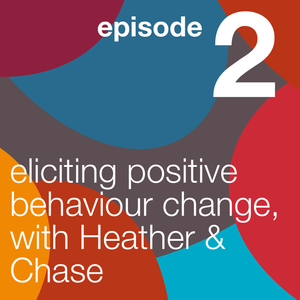
How to elicit positive behavioural change by engaging creatively and emotionally
Re-thinking The Human Factor with Bruce Hallas
06/29/17 • 61 min
How Heather and Chase are eliciting positive behaviour change in kids and their parents by engaging with them creatively and emotionally
EPISODE 02 SUMMARY - HEATHER DAHL AND CHASE CUNNINGHAM
————————————————
We talk with Heather Dahl and Chase Cunningham, co-founders of The Cynja, a comic series created with the aim of “[engaging] children... To teach them how to make smart choices [when they encounter the internet], practice online security, and enable privacy protection as they practice cyber security in their digital lives.” Heather and Chase bring a variety of work experience to the area of cyber security awareness and education and seek to bring a fresh, entertaining perspective to an otherwise drab communications M.O.
“...Sometimes in our families, it’s our kids that are educating the adults on the world that’s out there, and we can’t underestimate the role of comics in this sense for kids in educating all of those that are around them that may not be as digitally savvy as they are.”
In this episode, Bruce, Heather, and Chase discuss how creativity, emotion, and excitement are necessary ingredients in cyber security awareness/education materials, especially if the aim of those materials is to elicit engagement and behaviour change from an audience. In the same vein, they also discuss the power that lies within communication efforts that take into consideration the way a certain group of people speaks and engages with their world.
“And if you look to the world of marketing for example and how organizations market their products and services, and what’s the brand, there IS some of that excitement...If you want to sell a product, you connect with people on an emotional level.”
PROJECTS AND RESOURCES MENTIONED:
- The Cynja - https://www.cynja.com/
- The Analogies Project - https://theanalogiesproject.org/
CONNECT WITH Heather and Chase:
- Twitter - https://twitter.com/TheCynja
- Facebook -https://www.facebook.com/thecynja
- Pinterest - https://www.pinterest.com/thecynja/
Thank you for listening! Please subscribe to the podcast in iTunes, and if you enjoyed this interview, please share with your friends and colleagues and leave a 5 star rating and review.
Thanks for listening.
Bruce & The Re-thinking the Human Factor Podcast Team
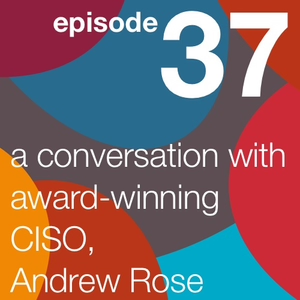
A conversation with award-winning CISO, Andrew Rose
Re-thinking The Human Factor with Bruce Hallas
04/28/20 • 63 min
ANDREW ROSE joins us for Series 3, Episode 12 of the Re-Thinking the Human Factor Podcast. Join us for this straight forward discussion with an award winning CISO who transformed security management for three major organisations.
With his extensive background, Andrew is a strong relationship manager who is able to develop and lead teams, driving initiatives forward with a style that is facilitative, tenacious and positive. Able to communicate, co-ordinate and influence effectively at all levels and respond to challenges with dedication, enthusiasm and pragmatism.
Andrew Rose is strongly focussed on sensible, cost effective security solutions being used to enable a business to innovate and develop.
AS YOU LISTEN TO THE EPISODE, IF YOU FIND YOURSELF WANTING TO IMPLEMENT SOME OF THE INSIGHTS YOU’RE GAINING BUT YOU FEEL YOU NEED A LITTLE HELP, PLEASE DO GET IN TOUCH WITH ME AT:
JOIN ANDREW ROSE AND BRUCE HALLAS AS THEY DISCUSS:
- The early days of cyber security and how people almost gave up on the human factor.
- How the idea of applying the knowledge of human awareness came into play.
- Challenges today’s cyber security managers face.
- How can you be safe if you are not secure?
- The key indicators to a healthy security culture.
- The influences that help to drive our decision-making and behaviour.
- Designing cyber security awareness and training with the human in mind.
- How to win over people to try something new.
- How hackers think.
RESOURCES AND TOPICS FOR FURTHER STUDY
MORE ABOUT ANDREW ROSE:
Please subscribe to the podcast in iTunes, and if you enjoyed this interview, please share with your friends and colleagues and leave a 5 star rating and review.
Thanks for listening and sharing.
Bruce & The Re-thinking the Human Factor Podcast Team
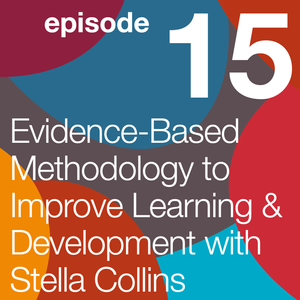
Evidence-Based Methodology For Improving Learning & Development
Re-thinking The Human Factor with Bruce Hallas
11/29/18 • 66 min
Did you know up to 80% of information is forgotten within 24 hours? Admittedly, this is not an encouraging statistic for those of us seeking to raise awareness, change behaviour, and foster an appropriate organizational culture.
For this reason, we at the Re-Thinking the Human Factor Podcast are looking for answers from outside the security industry from people who can provide an evidence-based path forward which can help us to improve learning and development. We’re happy to share some fresh insights with you on the topic of improving the training experience, likelihood of learning, and stickiness of memory after the training is completed.
Evidence-Based Methodology to Improve Learning and DevelopmentStella Collins joins Bruce in Series 2 / Episode 3 of the Re-Thinking The Human Factor podcast to have a deeper look into how we can improve learning and development using evidence base methodology.
She is a learning specialist, an expert in Brain Friendly learning, author of Neuroscience for Learning and Development, and the Creative Director of Stellar Learning, a business whose goal is to transform training, learning and communication - particularly when it's tough, technical or tortuous. They support and train their clients to build excellent relationships and make critical messages stick.
With a BSc in Psychology, an MSc in Human Communication, a coaching diploma, 15 years in the IT industry, and more than 15 years in L&D, she injects a theoretical knowledge of learning and communication with creative and practical ideas and hands-on experience. Stella says
“there’s no such thing as a boring topic – just boring training.”
JOIN STELLA COLLINS AND BRUCE HALLAS AS THEY DISCUSS:
- The importance of knowing the background behind a neuroscientific finding, i.e., who’s done the research, what was on their agenda when they did it, and whether the proper research methodology and statistical analysis was used to arrive at the conclusion on which your team is now basing its L&D and policy changes
- The empowering nature of evidence-based ideas
- Effective planning for L&D training, including making people excited about going through the training, and making the most of the time you have with people rather than wasting time and money on a captive audience that will forget most of what they learned within 24 hours (see our opening statement above)
- The importance of what happens after L&D training, like inter-staff communication and ensuring that the work environment is conducive to easy adoption of new skills and policies
- What is training, actually? Likewise, what is learning?
- Neuroplasticity, or the fact that our brains are flexible and able to create new pathways for learning throughout life
- Ways to maximizing the potential for learning when engaging in training efforts
- When it comes to learning and memory, humans are not sponges as the metaphor suggests
- The future of L&D and self-directed learning
“An experience, as opposed to fact...When we have an experience, we remember that sensory information... Emotion is massively sticky. Emotions and senses are hugely important.”
FURTHER STUDY AND RESEARCH
Neuroscienece for Learning and Development by Stella Collins
Stellar Learning (Make Your Message Sticky)
Choice Architecture
Neuroplasticity
MORE ABOUT STELLA COLLINS:
Please subscribe to the podcast in iTunes, and if you enjoyed this interview, please share with your friends and colleagues and leave a 5 star rating and review.
Thanks for listening and sharing.
Bruce & The Re-thinking the Human Factor Podcast Team
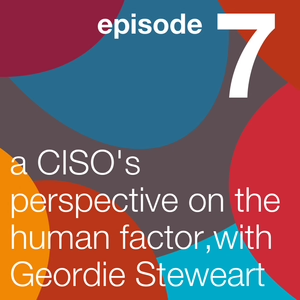
A CISO's Perspective on the Human Factor, with Geordie Stewart
Re-thinking The Human Factor with Bruce Hallas
12/22/17 • 65 min
EPISODE 07 SUMMARY - GEORDIE STEWART
————————————————
We’re taking a different approach to our chat in Episode 07 of the Re-thinking the Human Factor podcast. For this episode, we asked one of our listeners to come on the show and share with us the key lessons they’ve learned from the first three episodes of our show:
- Episode 01 - An Interview with Gregory Michaelidis, former Head Speech Writer for the Secretary of Homeland Security
- Episode 02 - An Interview with Heather Dahl and Chase Cunningham
- Episode 03 - A conversation With John Pollack, former Speechwriter to President Bill Clinton
Geordie Stewart joins Bruce Hallas in a discussion we hope will help you synthesize the vast amount of information covered in those episodes. Geordie is a CISO who has worked at organisations like of John Lewis, TUI UK & Europe and has most recently taken up residence at the UK’s largest Building Society, the Nationwide. As well as his day job he is an international speaker and keen innovator in the area of technology risk communication. His award winning masters thesis at the Royal Holloway Information Security Group examined information security awareness from a fresh perspective as a marketing and communications challenge. [1]
“And in a busy environment with lots of competing messages..., the challenge is, how do we make sure messages of value land in a way that somebody can use and benefit from?...because we are competing with HR, finance, and these other sources of information and guidance within companies.”
Join Geordie and Bruce as they give you the hash on:
- The necessity of understanding your audience and empathizing with them if you hope to effectively raise awareness, influence behaviour, and foster a culture amongst that audience
- How a lack of feedback loops and accurate metrics has effected the speed at which the security industry has evolved in their communication and training strategies
- The concept of the captive audience, and how having an audience built into the organizations that security professionals serve has stifled motivation to innovate and improve upon security awareness, behaviour, and culture communication and training
- The role that brand plays in terms of how it influences the level of engagement you’ll get from people and whether or not people will comply with organizational policies and procedures
RESOURCES AND TOPICS FOR FURTHER STUDY
- The Analogies Project
- Predictably Irrational by Dan Ariely
- ISC2
MORE ABOUT GEORDIE STEWART:
- Website [1]
Please subscribe to the podcast in iTunes, and if you enjoyed this interview, please share with your friends and colleagues and leave a 5 star rating and review.
Thanks for listening and sharing.
Bruce & The Re-thinking the Human Factor Podcast Team

The Accidental Security Specialist, with David Shipley
Re-thinking The Human Factor with Bruce Hallas
03/17/20 • 55 min
Living up to our promise to bring you fantastic guests, David Shipley joins us for Series 3, Episode 6 of the Re-Thinking the Human Factor Podcast. Time to go phishing so grab your rod.
David is a self professed accidental cyber security professional, but has spent time as a soldier, newspaper reporter and marketer. After a cyber hack within his company occurred, David grew increasingly interested in cyber security and was asked to take on this role within his company.
Currently based in Canada, David is an award-winning entrepreneur and head of Beauceron Security. Beauceron's holistic approach to measuring and reducing cyber risk brings together threat intelligence, user education and awareness, simulated attacks and real incident data into an easy-to-use and deploy cloud platform that transforms cybersecurity from an IT-centric issue into a pan-organization management opportunity.
AS YOU LISTEN TO THE EPISODE, IF YOU FIND YOURSELF WANTING TO IMPLEMENT SOME OF THE INSIGHTS YOU’RE GAINING BUT YOU FEEL YOU NEED A LITTLE HELP, PLEASE DO GET IN TOUCH WITH ME AT:
IN THIS EPISODE, DAVID SHIPLEY AND BRUCE HALLAS DISCUSS:- The sheepdog effect.
- Turning the cyber victims into defenders.
- Empowering the person.
- The importance of driving behavioural reinforcement within a culture to keep positive cyber security behaviour thriving.
- Getting the metrics correct- Repeat clickers and what we can learn.
- Taking the time to make sure people really retain new cyber security-related information and behaviours.
- Phishing fallibility:
- Is someone’s emotional state a factor to be considered?
- The 8 emotional scale.
- Fear response, social hi-jacking and engineering.
- How time affects people’s behaviour during a 24 hour period.
- The power of keeping calm. Speed can often be your enemy.
- The Power Model - what it is and how it can be used to boost cyber-security awareness:
- People, environment, actions and resources.
- Creating an easy to use protocol to gauge involvement.
- Learning from each other. Building a solid support structure.
- Black box culture - going deeper into more effective cyber security training:
- Talking about issues without laying blame.
- The story of the mayor that got phished.
- Learning from mistakes in proactive ways. Rewarding right behaviour.
- Scoring people and then helping them improve their performance within the security culture.
- Compliance:
- Exceeding compliance via relative, contextual, timely informative videos.
- Treat your audience like adults.
- Using Surveying as a tool to generate better metrics around risk and awareness:
- The importance of your baseline and the importance of a good survey.
- How does bias affect survey answers and are there ways around it?
- Using video responses to surveying to offer training in weak spots and offer guidance and support to colleagues.
- Start a positive feedback loop.
- Phishing attacks and data strategy.
- Data gathering from ‘time to click’ data proves to be very fruitful at limiting risk.
- Huge amounts of data are available to be mined to design cyber security awareness and education pieces that change behaviour.
- Having a strategy for data gathering is crucial. Learning when people click leads to a defined process towards a positive security culture.
- Cyber Security Marketing.
- The same tools that marketing applies can be used when trying to form a new culture of awareness within a business.
- What is a KPI clash?
- Where is the cyber security industry failing?
- Not enough focus on the human factor.
- Not enough funding for training.
- Real meaningful change comes with data and planning correctly
- Data driven decision making around security awareness.
- The need for sharing resources exists to help strengthen the entire security industry.
RESOURCES AND TOPICS FOR FURTHER STUDY
MORE ABOUT DAVID SHIPLEY:
Show more best episodes

Show more best episodes
FAQ
How many episodes does Re-thinking The Human Factor with Bruce Hallas have?
Re-thinking The Human Factor with Bruce Hallas currently has 58 episodes available.
What topics does Re-thinking The Human Factor with Bruce Hallas cover?
The podcast is about Culture, Behavior, Management, Storytelling, Podcasts, Technology, Cyber, Business, Awareness and Cybersecurity.
What is the most popular episode on Re-thinking The Human Factor with Bruce Hallas?
The episode title 'The human factor. A view from Brazil.' is the most popular.
What is the average episode length on Re-thinking The Human Factor with Bruce Hallas?
The average episode length on Re-thinking The Human Factor with Bruce Hallas is 61 minutes.
How often are episodes of Re-thinking The Human Factor with Bruce Hallas released?
Episodes of Re-thinking The Human Factor with Bruce Hallas are typically released every 14 days, 1 hour.
When was the first episode of Re-thinking The Human Factor with Bruce Hallas?
The first episode of Re-thinking The Human Factor with Bruce Hallas was released on May 31, 2017.
Show more FAQ

Show more FAQ